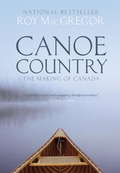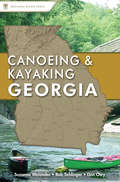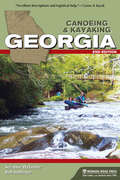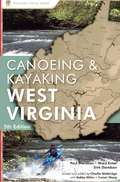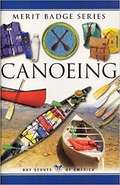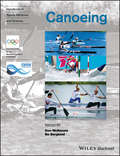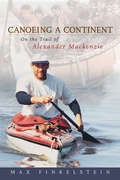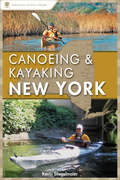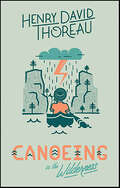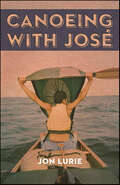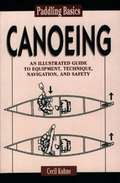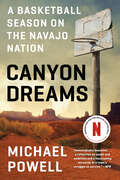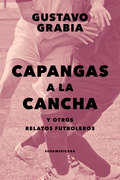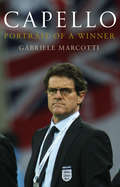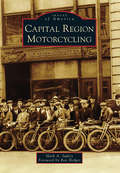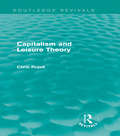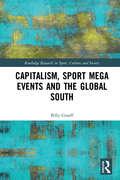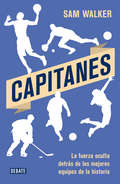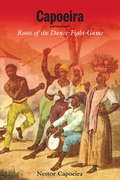- Table View
- List View
Canine Tracking Guide
by Don AbneyCanine Tracking Guide details the two most common uses of the canine nose: following blood trails for wounded game and tracking humans (from lost children and missing hikers, to escaped convicts). The author explains the concept of human scent and how the amazing canine nose functions and then elaborates on the basic training principles, commands, exercises and patterns used in tracking work. Whether a reader is working with hunting dogs, police dogs, cadaver dogs or competition dog, this guide offers the correct information needed for every tracking pursuit.
Canoe Country
by Roy MacgregorOne of our favourite chroniclers of all things Canadian presents a rollicking, personal, photo-filled history of the relationship between a country and its canoes. From the earliest explorers on the Columbia River in BC or the Mattawa in Ontario to a doomed expedition of voyageurs up the Nile to rescue Khartoum; from the author's family roots deep in the Algonquin wilderness to modern families who have canoed across the country (kids and dogs included): Canoe Country is Roy MacGregor's celebration of the essential and enduring love affair Canadians have with our first and still favourite means of getting around. Famous paddlers have been so enchanted with the canoe that one swore God made Canada as the perfect country in which to paddle it. Drawing on MacGregor's own decades spent whenever possible with a paddle in his hand, this is a story of high adventure on white water and the sweetest peace in nature's quietest corners, from the author best able (and most eager) to tell it.
Canoe Days
by Gary Paulsen Ruth Wright PaulsenOpening this book is like sitting down in a canoe, taking up a paddle, and gliding out into the summer beauty of a hidden lake. In this picture book that is as refreshing and inviting as a perfect canoe day, a fawn peeks out from the trees as ducklings fan out behind their mother. Butterflies pause and fish laze beneath the lily pads. Ruth Wright Paulsen's sunlit paintings and Gary Paulsen's poetic text capture all the peace and pleasure of a day when water and sky are one.
Canoe and Boat Building: A Complete Manual for Amateurs
by W. P. StephensFirst published over a century ago, this handy book offers timeless advice and instruction on designing and constructing a variety of small boats. Written especially for amateurs, this manual contains comprehensive, simply written directions for building canoes, rowing and sailing boats, and hunting craft.Canoe-building is treated in detail because, as the author points out, the processes involved are common to all types of small craft. Once mastered, the principles can be applied to simpler vessels such as the rowboat, skiff, and dory. The profusely illustrated text also includes hard-to-find coverage of building the Barnegat Sneakbox, the Rob Roy Canoe, and the Delaware Ducker. Additional chapters offer valuable guidelines for outfitting the craft with paddles, rudders, sails, and other equipment.Written by W. P. Stephens, a distinguished expert in the field, this volume will serve as a valuable companion for beginners in the craft of boat-building, as well as a useful and information-packed sourcebook for experienced builders.
Canoeing & Kayaking Georgia
by Don Otey Bob Sehlinger Suzanne WelanderCanoeing & Kayaking Georgia is the definitive guide to whitewater in the Peach State. It details the best of Georgia's streams with accurate descriptions and maps: from classics rivers, such as the Chattahoochee and Flint, to steep creeks like Overflow and Talking Rock.
Canoeing & Kayaking Georgia 2e
by Bob Sehlinger Suzanne WelanderCovering thousands of miles of Georgia's waterways, Canoeing & Kayaking Georgia is the definitive guide to Georgia's whitewater to wilderness swamps -- and everything in between.
Canoeing & Kayaking West Virginia
by Paul Davidson Turner Sharp Charlie Walbridge Bobby Miller Dirk Davidson Ward EisterCanoeing & Kayaking West Virginia is the definitive guide to whitewater in the Mountain State. More than 40 years after the initial printing, this book continues to bring paddlers the best of West Virginia's waters: from classics rivers, such as the Gauley, the New, and the Tygart, to steep creeks like North Fork of Blackwater and Meadow River.At-a-glance information for each river section helps boaters pick rivers to match their ability and current weather conditions, while river descriptions, gauge and shuttle route information provide additional critical information.Whether boating in kayaks, canoes, or sit-on-tops, paddlers will find more than enough rivers to fit their interest or skill level. In addition, literary interludes scattered throughout each book will invoke the spirit of paddling, encouraging readers' contemplation of past and future trips. Appendices include websites, gauge information, and safety information, making this book a valuable resource in planning out the next trip.
Canoeing (Merit Badge Series)
by Boy Scouts of AmericaThis book guides a scout through the requirements for earning the canoeing merit badge. It guides the scout so that they learn canoeing and all the safety and skill needs associated with this activity.
Canoeing (Olympic Handbook of Sports Medicine)
by Don McKenzie Bo BerglundA new volume in the Handbook of Sports Medicine and Science series from the International Olympic Committee, this volume Canoeing provides an accessible and comprehensive summary of the topic. Provides a concise, authoritative overview of the science, medicine and psycho-social aspects of canoeing Offers guidance on medical aspects unique to the training and coaching of canoe athletes The only book on this subject endorsed by the Medical Commission of the International Olympic Committee (IOC) and the International Canoe Federation (ICF) Written and edited by global thought leaders in sports medicine
Canoeing a Continent: On the Trail of Alexander Mackenzie
by Max FinkelsteinA highly personal account of the travels of Max Finkelstein as he retraces, some two hundred years later, the route of Alexander Mackenzie, the first European to cross North America (1793). Mackenzie’s water trail is now commemorated as the Alexander Mackenzie Voyageur Route. More than just a travelogue of a canoe trip across Canada, this is an account that crosses more than two centuries. It is an exploration into the heart and mind of Alexander Mackenzie, the explorer, and Max Finkelstein, the "Voyageur-in-Training." Using Mackenzie’s journals and his own journal writings, the author creates a view of the land from two vantage points. The author retraced the route of Alexander Mackenzie across North America from Ottawa through to Cumberland House, Saskatchewan, and paddled the Blackwater, Fraser and Peace Rivers, completing the trip in 1999. This route is the most significant water trail in North America, and perhaps the world. "A ’must-read’ for everyone who loves wild places and the magic of canoes." - Cliff Jacobson, Outdoor Writer & Consultant "Past and present collide in this journey of discovery across the map of Canada. Max craves the extremes. He relishes in coping with what nature throws at him, punishing himself to find his physical limits and experiencing firsthand the inherent dangers in such a voyage. With Alexander Mackenzie as his guide and inspiration, Max finds the strength to carry on against all odds to forge poignant historical and personal links in this incredible cross-Canada paddling odyssey." - Becky Mason, Artist and Paddler, Chelsea, Quebec
Canoeing and Kayaking Florida
by Johnny Molloy Elizabeth F. Carter John Pearce Lou Glaros Doug SpharCompletely updated, Canoeing & Kayaking Florida, 2nd is the most comprehensive guide to the best of Florida's unique streams, springs, creeks, and rivers. Engaging and concise yet filled with carefully selected details vital to any successful Florida paddling adventure, Canoeing & Kayaking Florida spares readers encyclopedic fluff in favor of practical, no-nonsense information. With expanded regional maps and revised river maps, Canoeing & Kayaking Florida is simply the best and most informative Florida paddling guide available.Florida has a lot of sand, but it also has a lot of water-and not just for drinking. It's only natural that native Floridians and transplants alike paddle and ply the waterways of this waterway-rich state. Of course, Florida's native Indians and subsequent settlers used the creeks, streams, and rivers long before the first plastic kayak or fiberglass canoe took to this watery paradise. In the early 1970s, the state of Florida established a canoe trail system, which was born out of paddlers discovering the many destinations here. For various reasons, this state-sanctioned canoe trail system lost momentum.Building on the state's efforts and adding their own discoveries, paddling enthusiasts Elizabeth F. Carter and John L. Pearce brought together the rich and varied streams, creeks, and rivers of Florida. Together, they penned the original version of portions of this book, A Canoeing & Kayaking Guide to the Streams of Florida, Volume I. Their book covered the north central part of the state as well as the panhandle. This was followed by A Canoeing & Kayaking Guide to the Streams of Florida, Volume II, written by Lou Glaros and Doug Sphar. Their book covered the southern half of the state.Paddling grew steadily in Florida due in part to these excellent guidebooks, establishment of paddling clubs, positioning of outfitters on rivers, and population growth. More people explored new waterways, not only in new kayaks made of varied plastic but also ultra-lightweight canoes easy to paddle and transport. More recently, a rise in the use of recreational kayaks has led to a rebirth of paddling's popularity.In 2004, Molloy worked on a new consolidated paddling guide to Florida and refloated previously covered rivers, checking access points, and floated new waterways to highlight newer opportunities for Florida paddlers. Several new wilderness streams were added to the book. In the new 2007 edition, Molloy and Elizabeth Carter added a few more streams, and revised the maps for easier use.For over 20 years, Menasha Ridge Press's Canoeing & Kayaking Florida has provided the essential information needed to paddle the waterways of the Sunshine State.
Canoeing and Kayaking New York
by Kevin StiegelmaierCanoeing and Kayaking New York includes descriptions of 50 of the best trips on New York's dozens of rivers. Along with runs for both experienced paddlers and novices and profiles for both over-nighters and short, round-trip day paddles, this book contains all the information necessary for a safe, enjoyable trip. Kevin Stiegelmaier combines information about tides, river gauges, GPS waypoints, and maps with personal anecdotes, historical trivia, and descriptions of local plants and animals, sprinkled with a touch of humor.
Canoeing in the Wilderness
by Henry David ThoreauThoreau’s famous trip through the Maine Woods reissued to entertain, encourage, and inspire contemporary naturalists. Thoreau paints the woods and waterways of Maine with the same loving hand that described his Walden home, and entertains with the successes and difficulties of the trip and the quirks of his companion and their guide, Joseph Polis, told with a wit and insight that can only be found in Thoreau.
Canoeing the Boundary Waters
by Marion StresauThe Account of One Family's Explorations in the Boundary Waters Canoe Area.
Canoeing with José
by Jon LurieThe first time journalist Jon Lurie meets José Perez, the smart, angry, fifteen-year-old Lakota-Puerto Rican draws blood. Five years later, both men are floundering. Lurie, now in his thirties, is newly divorced, depressed, and self-medicating. José is embedded in a haze of women and street feuds. Both lack a meaningful connection to their cultural roots: Lurie feels an absence of identity as the son of a Holocaust survivor who is reluctant to talk about her experience, and for José, communal history has been obliterated by centuries of oppression.Then Lurie hits upon a plan to save them. After years of admiring the journey described in Eric Arnold Sevareid&’s 1935 classic account, Canoeing with the Cree, Lurie invites José to join him in retracing Sevareid&’s route and embarking on a mythic two thousand-mile paddle from Breckenridge, Minnesota, to the Hudson Bay.Faced with plagues of mosquitoes, extreme weather, suspicious law enforcement officers, tricky border crossings, and José&’s preference for Kanye West over the great outdoors, the journey becomes an odyssey of self-discovery. Acknowledging the erased native histories that Sevareid&’s prejudicial account could not perceive, and written in gritty, honest prose, Canoeing with José is a remarkable journey.
Canoeing with the Cree
by Eric SevareidIn 1930 two novice paddlers--Eric Sevareid and Walter C. Port--launched a secondhand 18-foot canvas canoe into the Minnesota River at Fort Snelling for an ambitious summer-long journey from Minneapolis to Hudson Bay. Without benefit of radio, motor, or good maps, the teenagers made their way over 2,250 miles of rivers, lakes, and difficult portages. Nearly four months later, after shooting hundreds of sets of rapids and surviving exceedingly bad conditions and even worse advice, the ragged, hungry adventurers arrived in York Factory on Hudson Bay--with winter freeze-up on their heels. First published in 1935, Canoeing with the Cree is Sevareid's classic account of this youthful odyssey. The newspaper stories that Sevareid wrote on this trip launched his distinguished journalism career, which included more than a decade as a television correspondent and commentator on the CBS Evening News.
Canoeing: Paddling Basics
by Cecil KuhneIncludes: Elements and construction of the canoe; Determining the appropriate canoe for different water types; Recognizing and navigating river hazards and rapids; Planning and equipping day and overnight trips; Basic and advanced, solo and tandem paddling techniques; Safety and rescue procedures.
Canyon Dreams: A Basketball Season on the Navajo Nation
by Michael PowellThe moving story of a Navajo high school basketball team, its members struggling with the everyday challenges of high school, adolescence, and family, and the great and unique obstacles facing Native Americans living on reservations. Deep in the heart of northern Arizona, in a small and isolated patch of the vast 17.5-million-acre Navajo reservation, sits Chinle High School. Here, basketball is passion, passed from grandparent to parent to child. Rez Ball is a sport for winters where dark and cold descend fast and there is little else to do but roam mesa tops, work, and wonder what the future holds. The town has 4,500 residents and the high school arena seats 7,000. Fans drive thirty, fifty, even eighty miles to see the fast-paced and highly competitive matchups that are more than just games to players and fans. Celebrated Times journalist Michael Powell brings us a narrative of triumph and hardship, a moving story about a basketball team on a Navajo reservation that shows how important sports can be to youths in struggling communities, and the transcendent magic and painful realities that confront Native Americans living on reservations. This book details his season-long immersion in the team, town, and culture, in which there were exhilarating wins, crushing losses, and conversations on long bus rides across the desert about dreams of leaving home and the fear of the same.
Capangas a la cancha: Y otros relatos futboleros
by Gustavo GrabiaEstos relatos de Gustavo Grabia, en línea con la riquísima tradición argentina de cuentos de fútbol, presentan una voz tan original como entrañable. Un extravagante sociólogo plantea una idea revolucionaria para terminar, de una vez por todas, con la violencia en el fútbol. Un rústico de casi treinta años, al que nunca eligen en los picados, se propone entrenar sin descanso para convertirse en jugador profesional. Una complicidad trasciende el campo de juego y se empieza a transformar en erotismo. Un grupo de amigos sufre la partida de su arquero y, ante la imposibilidad de sumar otro jugador, se ve obligado a dejar el fútbol 5 de los miércoles y... cambiar de deporte. Estas son solo algunas de las jugadas de Capangas a la cancha, un libro de gambetas y piernas de más, de terrores al descenso y victorias barriales imborrables. Estos relatos de Gustavo Grabia, siguiendo la riquísima tradición argentina de cuentos de fútbol, presentan una voz tan original como entrañable.
Capello: Portrait Of A Winner
by Gabriele MarcottiFabio Capello is a born winner. As a midfielder with Roma, Juventus and Milan, he won four Italian league championships and two cups, and played for his country 32 times, scoring a goal at Wembley in 1973 in Italy's first ever win in England. As a manager, Capello's fierce determination has seen him win championships with every club he has taken charge of, from Milan in the early 1990s to Real Madrid with David Beckham in 2007.Now he faces his greatest challenge yet: to restore England to the top of world football and take them to the World Cup in South Africa in 2010 - and win. For Capello, nothing less than the best will do.In Capello: Portrait of a Winner, award-winning writer Gabriele Marcotti travels from Capello's early days in Italy to the first months in his new job to tell the story of the man behind the steely glare. Capello has made more than a few enemies over the years, and Marcotti has talked to them all, as well as his closest associates. No-one has ever got this close to Capello before, and this is the story not just of a remarkable career, but of the life of a truly extraordinary man.
Capital Region Motorcycling (Images of America)
by Mark A. Supley Ron HedgerThe early 20th century was a time of greatness and prosperity for New York's Capital Region. Economically powerful cities like Albany and Schenectady were home to emergent companies that employed a growing population. This influx gave way to an abundance of stores and retail establishments that catered to newly settled residents. With the local economy experiencing unprecedented growth, people had discretionary income to be used for leisure activities, such as going to Proctor's Theater or enjoying the sport of motorcycling. Capital Region Motorcycling reveals the many activities that were enjoyed by those who wished to participate or watch. Photographs of road tours, polo matches, hill climbs, field meets, scrambles, and short-track and ice racing are featured alongside stories of the Electric City Riders and Spitzies Roamers motorcycle clubs.
Capitalism and Leisure Theory (Social Science Paperback Ser. #No. 291)
by Chris RojekFirst published in 1985, this title explores theories of leisure in a capitalist society. Basing his argument on a refutation of the conventional association of leisure with freedom and free time, Chris Rojek examines the four main structural characteristics of modern leisure practice: privatisation, individuation, commercialisation and pacification. The writings of Marx, Durkheim, Weber, and Freud are used to locate the question of leisure in more mainstream social theory. This interesting reissue will be of particular value to students of sociology and leisure studies, and those with an interest in the relationship between leisure and power.
Capitalism, Sport Mega Events and the Global South (Routledge Research in Sport, Culture and Society)
by Billy GraeffWhat are the social, political and economic consequences of staging sport mega events such as the Olympics and the World Cup? Capitalism, Sport Mega Events and the Global South presents a new approach to sport mega events and related issues, exploring elements that are not present or are not developed in the existing literature. This book explores the socioeconomic impact of these events on host countries in the Global South. Drawing on a thorough case study of the 2014 FIFA World Cup in Brazil, it examines how the residents of Porto Alegre perceived how they were affected and considers the relationship between sport mega events and the wider social sphere of global capitalism. Supported by original socioeconomic research conducted in the area, this is fascinating reading for all students and scholars interested in sport mega events, sport tourism, international development, sport geography and the sociology of sport.
Capitanes
by Sam WalkerSam Walker examina en este fascinante ensayo la clave del éxito de los mejores equipos deportivos del mundo, y llega a sorprendentes conclusiones: la fuerza oculta detrás de los equipos más legendarios de la historia no es el entrenador, ni la estrella; no es el dinero ni la estrategia; es una cuestión totalmente distinta... Capitanes ha sido incluido en las listas:Top Business and Leadership Book de 2017 de Amazony 13 Best Business Books of 2017 de CNBC Hace diez años, Sam Walker decidió contestar la pregunta más controvertida sobre deporte: ¿cuáles son los equipos más exitosos de todos los tiempos? Mediante la estadística, identificó los 16 equipos con mayores triunfos a su espalda en todos los deportes, desde el fútbol, hasta el baloncesto, pasando por el rugby o el voleibol femenino. El siguiente paso era inevitable: ¿qué características en común tenían estos superequipos? Según avanzaba, Walker encontró un patrón: todos ellos tenían detrás un tipo muy especial de líder, un capitán, pero no el que uno esperaría. Eran anomalías heterodoxas, raros y poco sociables, no muy talentosos, malos comunicadores, rompían las reglas y, en vez de reclamar atención, preferían un segundo plano. Unos capitanes muy diferentes de lo que se espera de líderes inspiradores. A partir de equipos tan famosos como el F.C. Barcelona, la selección brasileña, los All Blacks o los New York Yankees, y otros menos conocidos como el equipo de hockey sobre hielo soviético o el de balonmano francés, Capitanes revela las siete cualidades fundamentales que un líder excepcional necesita. Basado en entrevistas exclusivas con atletas, entrenadores y dirigentes de decenas de países, Walker explica si los líderes nacen o se hacen, y por qué a veces se elige al capitán equivocado. No es solo un libro sobre deportes, es la clave de cómo se construyen grandes equipos y en qué se basa el liderazgo exitoso. Reseña:«Un buen libro sobre liderazgo que, muy inteligentemente, se hace pasar por un libro sobre deportes.»Andrew Ross Sorkin, The New York Times
Capoeira
by Nestor CapoeiraCapoeira is simultaneously a dance, a fight, and a game. Created by the Africans brought to Brazil as slaves beginning in 1500, capoeira was forbidden by law but survived underground. When open practice was allowed in the 1930s it soon became very popular. Capoeira came to America around 1975, and has become widely recognized by dancers and martial artists. The author discusses capoeira's evolution from Brazilian street play into a way of life. The philosophy of capoeira, and the practical and spiritual benefits of this philosophy, are also discussed. Instructions and exercises in intermediate and advanced skills take up where the author's previous book left off. The book includes 100 black-and-white photos and illustrations.

